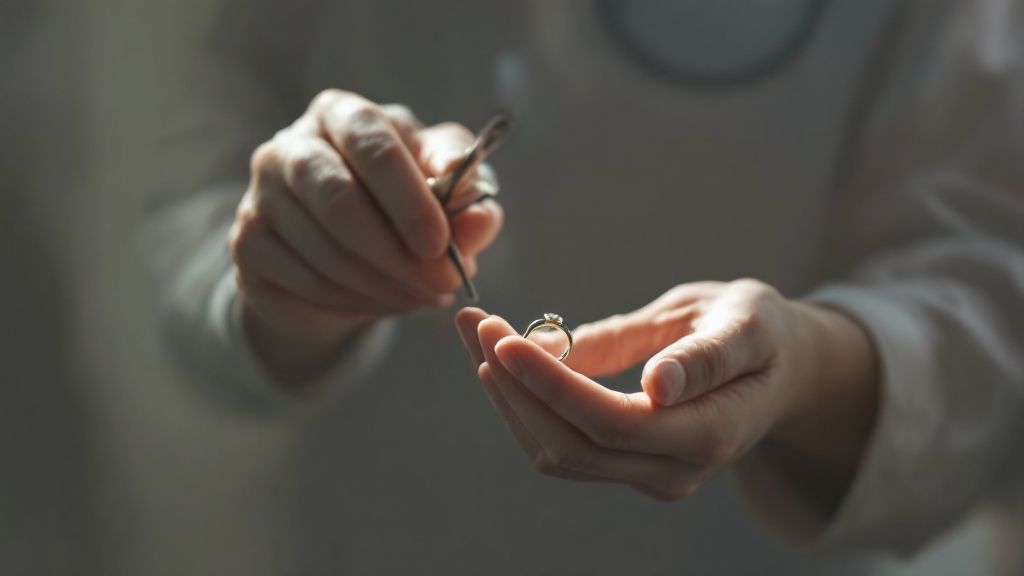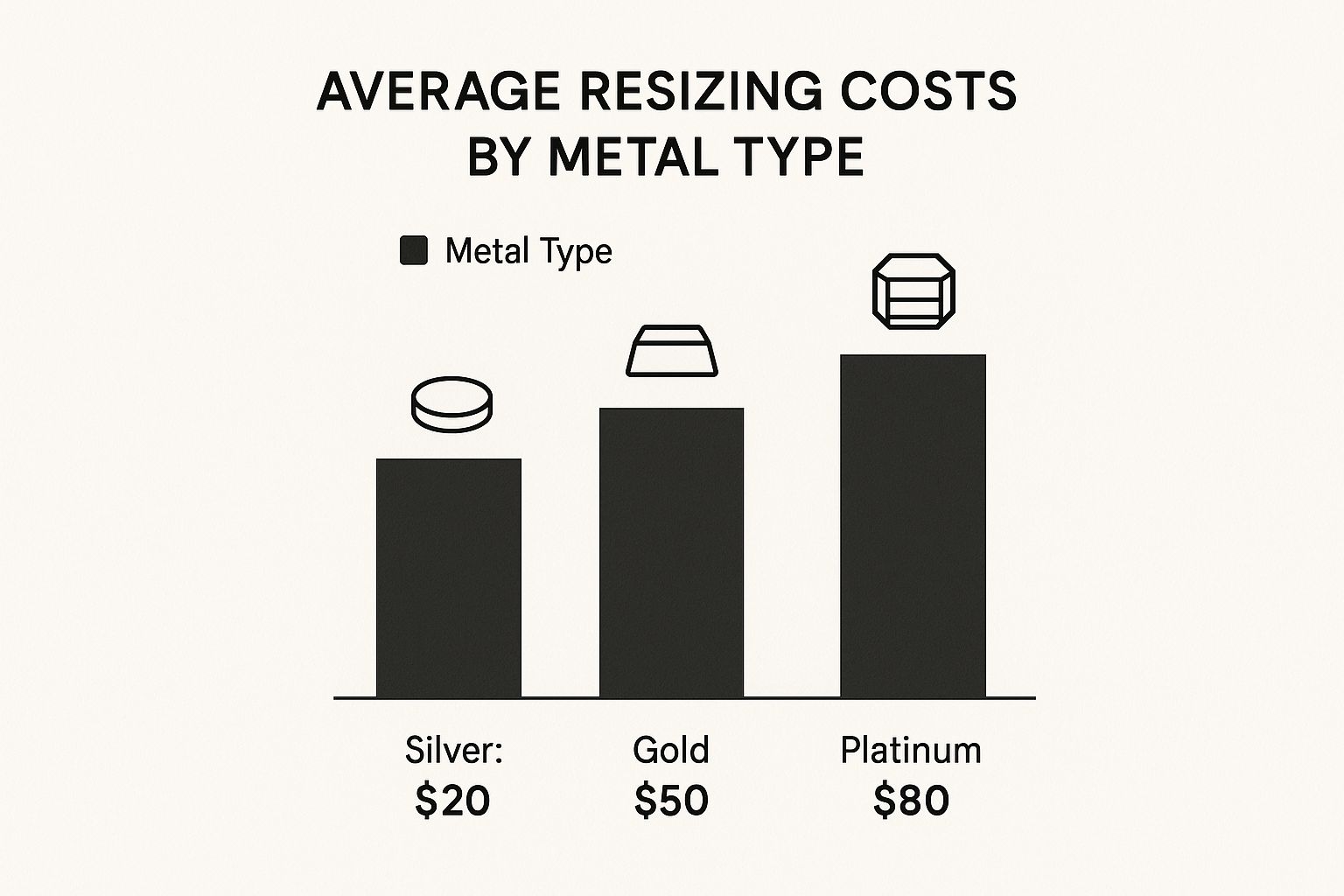How to Get a Ring Resized The Complete Guide
- Luke Zucco
- Sep 12
- 11 min read
So, you've got a ring that doesn't quite fit. Don't worry, resizing is one of the most common and straightforward jobs for a good jeweler. The basic idea is that they'll precisely measure your finger, take a close look at your ring, and then skillfully add or remove a tiny piece of the metal band to make it fit you perfectly.
Your First Steps to a Perfectly Sized Ring
Getting a cherished ring resized can feel a little nerve-wracking, but it's a routine task for any experienced jeweler. Before you head out, there are a few things you can check yourself to make the whole process smoother and ensure you know what to expect.
First up, take a good look at the ring's design. Is it a simple, plain band, or does it have a more complex style? Certain rings, like eternity bands with stones set all the way around, or those made from tough metals like tungsten, are notoriously difficult—or sometimes impossible—to resize. Knowing the limitations of your specific ring is the best place to start.
Here's a quick checklist to run through before you even talk to a jeweler. It helps you get a clearer picture of what you're working with.
Quick Resizing Checklist
Check | What to Look For | Why It Matters |
|---|---|---|
Ring Material | Is it gold, platinum, silver, or an alternative metal like tungsten or titanium? | Precious metals are easy to work with. Alternative metals often can't be resized. |
Band Design | Is it a plain band or an eternity style with continuous stones? | Eternity bands can't be cut without disrupting the pattern, making resizing nearly impossible. |
Stone Settings | Are there stones set near the bottom (shank) of the ring? | Reshaping the band can loosen these settings, so a jeweler needs to be extra careful. |
Engravings | Is there an inscription on the inside of the band? | Cutting the band will interrupt the engraving, which might need to be redone. |
Thinking about these points ahead of time will help you have a much more productive conversation when you find a professional.
Determining Your True Size
Next, you need to nail down your actual ring size, and it’s a bit trickier than you might think. Your fingers can swell or shrink throughout the day based on everything from the temperature to how much water you've had to drink.
For the most reliable measurement, try checking your size in the afternoon when your body is at a stable temperature. Definitely avoid measuring right after a workout or when you first wake up. For a complete guide, you can learn how to measure for a ring size at home.
Here's a pro tip: Never rely on a single measurement. For a ring you plan to wear every day, get sized a few different times on different days. This helps you find a comfortable average that will feel right no matter what.
Finding a Trusted Jeweler
With your ring assessed and a good idea of your size, it’s time to find a jeweler you can trust. This is the most important part—you're handing over something valuable, after all.
The demand for skilled jewelers is on the rise. With the global jewelry customization market valued at $4.99 billion in 2021 and still growing, it's clear people want personalized, perfectly fitting pieces. This just underscores how crucial it is to find a true professional who has the expertise to handle your ring with the care it deserves.
Can Your Ring Actually Be Resized?

Before you even start looking for a jeweler, the first question to ask is: can this ring even be resized? Not every ring is a good candidate, and figuring this out upfront will save you a lot of time and potential disappointment. The two biggest factors are what the ring is made of and how it’s designed.
Let's start with the metal, because that's usually the make-or-break element.
Precious metals are a jeweler's bread and butter. Gold and silver are fantastic to work with because they're soft and malleable. A skilled hand can easily cut, solder, and reshape them without compromising the ring's structure.
Platinum is another common one. It's a bit tougher and requires more specialized tools and higher heat to work with, but any experienced jeweler will have no problem resizing it.
The Problem Metals
Then you have the more modern metals, and this is where things get tricky. Some of them are almost impossible to alter.
Tungsten carbide, for instance, is incredibly hard and brittle. If you try to cut it, it's more likely to shatter than anything else. Titanium and stainless steel also pose a huge challenge because of their sheer strength and high melting points.
The global jewelry market was estimated at $366.79 billion in 2024, with fine jewelry making up a dominant 68% of that share. Rings are a huge part of that. Knowing your ring can be resized ensures you can wear that investment for a lifetime.
When the Design Gets in the Way
Beyond the metal, the ring’s design itself can be a roadblock. A simple, plain band? Easy. But add in some intricate details, and you’re looking at a much bigger challenge.
An eternity band is the classic example. With gemstones running all the way around, there’s simply no place to cut the band without disrupting the entire pattern of the setting.
Other designs that can cause headaches include:
Rings with delicate filigree work
Pave settings that cover most of the band
Bands with detailed, continuous engravings
A jeweler might risk ruining the pattern or compromising the stone settings just by trying to make a change.
If you find out your ring can’t be resized because of its metal or unique design, it might be time to look at it in a different light. Sometimes, a piece's value is in its history. You may want to identify valuable antiques to see if its worth lies in its story rather than its ability to be worn.
Finding the Right Jeweler for the Job

This is the single most important decision you’ll make. Handing over something as precious as an engagement ring or a family heirloom requires a massive amount of trust. You’re not just looking for a service; you’re looking for a true professional with proven expertise.
Often, the first choice is whether to go back to the original seller or find a trusted local jeweler. The retailer who sold you the ring knows its exact specs, which is a definite plus. On the other hand, a local specialist can often offer more personalized service and a much quicker turnaround.
Vetting Your Jeweler: What to Ask
Before you leave your ring with anyone, you need to do your homework. Don't be shy about asking direct questions—it’s your job to gauge their skill and process. This isn’t just about finding a good price; it’s about protecting your investment.
Think of it like the art of bespoke tailoring, where every stitch is done with precision and artistry. A great jeweler brings that same level of detailed craftsmanship to your piece.
Here are the crucial questions I always recommend asking:
Do you perform the resizing work on-site? It's a big red flag if they have to ship it out. A jeweler with an in-house workshop maintains complete control, which significantly reduces the risk of your ring getting lost or damaged in transit.
What's your experience with this specific metal? This is huge. Resizing platinum, for instance, requires specialized tools and much higher temperatures than working with gold. You want someone who knows the material inside and out.
What soldering technique will you use? A top-tier jeweler will almost always use a laser welder. It creates a nearly invisible seam and is the best choice for delicate bands or rings with intricate settings.
Pro Tip: Always verify a jeweler's credentials. Look for certifications from respected organizations like the American Gem Society (AGS) or Jewelers of America (JA). These affiliations signal a serious commitment to high ethical standards and continuing education in the craft.
Finally, do a deep dive into their online reviews. Don’t just glance at the star rating. Read what actual customers say about their craftsmanship and reliability, specifically for resizing and repair jobs. A stream of positive feedback detailing a flawless resizing process is the green light you’re looking for.
Understanding the Resizing Process and Costs
So, you’ve found a jeweler you trust. What actually happens behind the counter when you hand over your ring? It’s not magic, but it does require a ton of skill and precision. The exact method a jeweler uses depends on one simple question: does the ring need to get bigger or smaller?
How Jewelers Adjust Your Ring's Size
If your ring is too loose, the process is pretty straightforward. A jeweler will snip a tiny piece out of the band (what they call the shank). Then, they'll expertly bend the two ends together to form a perfect circle again, soldering them shut with a torch. A final polish makes the seam vanish completely. It's an art form.
Making a ring larger is a bit more complex. For a small jump—say, half a size—they might be able to simply stretch the existing metal. But for anything more, they’ll need to cut the band and add a small piece of matching metal, carefully soldering it in to bridge the gap.
What Goes Into the Final Price?
The cost to get a ring resized isn't one-size-fits-all. Sizing down a simple silver band is a world away from sizing up an intricate platinum engagement ring. Several factors play into the final quote you'll receive.
Here’s a quick look at how the costs can vary by the type of metal involved.

As you might guess, platinum is the priciest. It’s incredibly dense and has a high melting point, which means the jeweler needs specialized tools and a lot more heat to work with it.
You can generally expect to pay between $20 and $150 for a professional resizing. It’s an incredibly common job for jewelers, making up about 10-15% of all the services they perform.
The price you pay ultimately comes down to a few key things:
The Metal: Softer metals like yellow gold and silver are easier (and cheaper) to work with than tough ones like platinum or titanium.
The Size Change: Going up in size costs more. Why? The jeweler has to add new precious metal to the band, and you're paying for that material.
The Ring’s Design: A plain, simple band is the easiest job. If your ring has a complex setting, channel-set stones, or a pavé band (covered in tiny diamonds), the labor—and the bill—goes up significantly.
Estimated Ring Resizing Costs by Metal and Complexity
To give you a clearer picture, I've put together a table with some ballpark figures. Remember, these are just estimates, and your local jeweler's prices might be different.
Metal Type | Sizing Down (Estimate) | Sizing Up (Estimate) | Complexity Factors |
|---|---|---|---|
Yellow Gold | $20 - $50 | $40 - $75 | Relatively soft and easy to work with. |
White Gold | $30 - $60 | $50 - $100 | Requires re-plating with rhodium after sizing, which adds to the cost. |
Rose Gold | $30 - $60 | $50 - $90 | Can be slightly more brittle than yellow gold, requiring more care. |
Silver | $20 - $45 | $30 - $60 | Very affordable, but may tarnish or show seams if not done by a skilled jeweler. |
Platinum | $60 - $100 | $80 - $150+ | High melting point requires special tools and more labor. |
Titanium | $50 - $100 | Not always possible | Extremely hard metal; often cannot be sized up and is difficult to size down. |
Ultimately, getting a quote from a few different jewelers is the best way to understand your specific costs.
While I always suggest a professional for any valuable or sentimental pieces, sometimes you just need a quick, temporary fix. If you're curious about those options, take a look at our guide on how to resize a ring at home using safe DIY methods.
You've Got Your Ring Back—Now What?

Getting that call from the jeweler is always exciting. But before you rush out the door, remember this: the job isn't done until you've given the ring a final once-over.
Take a moment right there at the counter to inspect their work. Don't feel like you're being picky or rushing the jeweler—they expect it. A true professional will be proud of their craftsmanship and will want you to see it up close.
First things first, try it on. How does it feel? The ring should slide over your knuckle with a little bit of effort but then sit comfortably at the base of your finger. It shouldn’t be spinning around freely or feel like it’s cutting off your circulation.
Keep in mind that a proper resizing takes time. If you're curious about the factors that can affect the turnaround, our guide on how long ring resizing takes breaks it all down.
Your Final Inspection Checklist
Now, it's time to play detective. Hold the ring up to the light and really look at the spot where the jeweler worked, usually at the bottom of the shank. A seamless, professional job should be almost impossible to spot.
Here’s what you’re looking for:
No Solder Lines or Seams: The surface should be perfectly smooth. You shouldn’t see any tell-tale lines, marks, or discoloration where the metal was cut and rejoined.
A Perfectly Round Band: Look at the ring from the side. Does it still look like a perfect circle? Sometimes a quick resizing job can leave the band looking slightly oval or warped.
Secure Stones: This is a big one. Gently press on any stones near the area that was resized. They should feel completely solid in their settings with absolutely no wiggling or movement. The heat from soldering can sometimes loosen prongs.
Crucial Takeaway: Did the jeweler add a significant amount of gold or platinum to size your ring up? If so, its value may have increased. It's a wise move to ask for an updated appraisal to make sure your insurance policy still provides adequate coverage.
Common Ring Resizing Questions
Stepping into the world of jewelry repair can feel a bit intimidating, and when it's about something as personal as your ring, you want to get it right. It's totally normal to have a lot of questions.
Let's walk through some of the most common things people worry about when they need a ring resized. Getting these answers upfront will help you know what to expect and ensure your ring stays beautiful for years to come.
How Many Times Can a Ring Be Resized?
This is a big one. For a simple, solid gold or platinum band, you can usually get away with resizing it two, maybe even three times, without causing any real problems. But it's good to remember that every time a jeweler cuts, solders, and reshapes the metal, it undergoes a bit of stress. Over time, this can make the band slightly thinner and more delicate.
Things get trickier with more complex rings.
Rings with intricate settings, like pavé or channel-set stones, can become unstable if they're adjusted too much.
Detailed engravings or patterns can get warped or even erased during the process.
Very thin, delicate bands just don't have enough metal to safely work with over and over.
A good jeweler's top priority is always the ring's long-term health. If they tell you another resize isn't a good idea, they're not trying to be difficult—they're trying to prevent a cracked band or lost diamonds down the road.
Will Resizing Decrease My Ring's Value?
When done correctly by a skilled professional, resizing will not devalue your ring. Think about it: a ring that fits perfectly is one you can actually wear and enjoy, which adds to its personal value immensely. The only time you risk losing value is if the job is done poorly.
A bad resizing job can be pretty obvious if you know what to look for:
Clear seams or sloppy solder marks
A band that's no longer perfectly round
A slight discoloration where the metal was joined
Gemstones that feel loose in their settings
This is exactly why finding a jeweler you trust is the single most important part of the whole process. Their craftsmanship is what protects the ring's beauty, its structural integrity, and ultimately, its monetary value. A great resize should be completely invisible.
What if My Ring Cannot Be Resized?
So, what happens if a jeweler tells you your ring can't be resized? It's more common than you'd think, especially with materials like tungsten or with full eternity bands where diamonds go all the way around. Don't worry, you still have some great options.
You could always wear the ring on a different finger or hang it on a nice chain as a necklace. If the ring is just a little too big, a jeweler can add tiny sizing beads or a spring insert inside the band. These are clever little additions that make the fit snugger without permanently changing the ring.
If the ring is too small and can't be stretched, the best bet is often to have a jeweler carefully remove the gemstones and create a new, identical setting in your exact size. This way, you keep all the important parts of the original ring in a new band that fits you perfectly.
At Panther De Luxe Shop, we believe every piece of jewelry should be worn and cherished. Explore our stunning collections and find a piece that fits you perfectly from day one at https://www.pantherdeluxe.com.

Comments